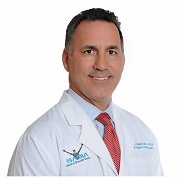Orthopedic Surgeon Dr. Alejandro Badia with Badia Hand to Shoulder Center and OrthoNOW, offers tips to reduce players’ risks on court.
MIAMI (PRWEB) November 13, 2018
The best treatment for “tennis elbow,” a painful, repetitive-motion disorder, may well be “wait-and-see,” report researchers in the November 2018 issue of the American Journal of Sports Medicine. They say, with time, the condition often resolves on its own. Noted Miami-based orthopedic surgeon, Alejandro Badia, MD, does not necessarily agree with that strategy, at least when it involves injury to the elbow or any other upper limb of active tennis players and athletes.
“For those playing tennis competitively or just recreationally, the highest quality approach is the one that gets them back on the court as quickly as possible,” says Dr. Badia, founder of Badia Hand to Shoulder Center and OrthoNOW®, who specializes in treating injuries of the upper limbs – wrist, fingers, elbow and shoulder – and whose patients have included some of the world’s elite tennis players.
Lateral epicondylitis — tennis elbow — is common in the general population, occurring when tendons at the elbow develop small tears and become inflamed due to repetitive motion, and the condition is often resistant to treatment, says Dr. Badia, who recently presented a broad lecture on tennis injuries to wrist and elbow at the annual Lyon International wrist conference as well as the World College of Exercise and sports medicine conference in Dublin.
“But, in sports, playing through pain is not the recommended option; it can simply worsen a problem and make it more difficult to manage,” he states.
“Tennis is demanding. It requires strong, supple upper limbs to control the racquet, which functions as an extension of the athlete’s dominant arm,” explains Dr. Badia. “Upper-limb injuries tend to be more chronic and more difficult to diagnose and manage than injuries to the lower limbs, like knee, ankle or foot.”
Consistently poor execution in playing tennis, such as striking the ball with the wrist in an awkward position, or a fall on the court can traumatize an upper limb, but, more commonly, the pain and swelling that develop in a hand, wrist, elbow or shoulder are due to overuse of muscles, tendons, ligaments, cartilage and other soft tissues.
A report in a March 2018 Orthoplastic Surgery & Orthopedic Care International Journal indicates about two-thirds of injuries in tennis are due to overuse, most often affecting shoulders, wrists and elbows.
Overuse, especially in older players, also may exacerbate other underlying and age-related problems, like osteoarthritis of the hand, carpal tunnel syndrome or tendonitis in the wrist, and bursitis – impingement syndrome – in the shoulder, Dr. Badia says.
Tennis is a widely-popular global sport. In the United States, some 17.9 million people play tennis, say researchers in an article in the March 2018 issue of Current Reviews in Musculoskeletal Medicine.
Although health experts say minor injuries can normally be treated with “rest, ice and elevation,” Dr. Badia emphasizes that more chronic problems, especially those of the upper limbs, should receive early, accurate diagnosis and treatment by an orthopedic or sports medicine specialist preferably specializing in the hand and upper limb. Players who experience persistent pain in any joint area are advised to see a physician “sooner rather than later,” he says.
Oral anti-inflammatory medications or corticosteroid injections, coupled with stretching or strengthening therapy, may mitigate pain in an elbow, shoulder, wrist or hand. If the problem proves resistant to conservative treatment or is more serious, like a tendon tear in the shoulder’s rotator cuff, then surgery may be needed.
Dr. Badia specializes in small-joint arthroscopic procedures, in which the surgeon works through tiny incisions to make necessary repairs. Arthroscopic surgery lessens post-operative pain, cuts recovery time and gets tennis players back on the court more quickly.
“Development of new techniques now allows for minimally invasive, arthroscopic approaches in many cases where open surgery was once required,” says Dr. Badia, who has pioneered his own surgical advancements, including correction of a tear in the triangular fibrocartilage deep inside the wrist. In that procedure, he welds, rather than ties, the suture, allowing for a stronger repair of the cartilage and eliminating any discomfort that a player might experience from having suture knots under the skin.
Of course, injury prevention trumps injury treatment every time. That’s why Dr. Badia offers these basic tips to limit tennis injury risks, especially among recreational players:
- Learn proper technique for playing the game.
- Make sure to use the correct equipment. Racquets with grips too large or too narrow for one’s hand, for example, can lead to wrist, hand and finger problems.
- Do strength-building exercises regularly. Warm up before a match.
- Consider the use of the Xtensor device, an innovative tool to strengthen the often neglected extensors as compared to the flexors of the wrist/hand.
- Take breaks – during practice and between matches.
- Make sure the tennis court is dry and clear of debris.
An internationally renowned hand and upper-limb surgeon, Alejandro Badia, MD, FACS, is founder and chief medical officer of the Florida-based Badia Hand to Shoulder Center and of OrthoNOW®, a walk-in orthopedic care clinic. http://www.drbadia.com, http://www.orthonowcare.com

